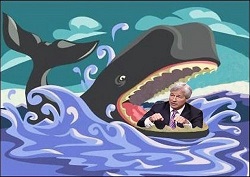by Pam Martens and Russ Martens, Wall St On Parade:

On June 11, 2015, the Office of Financial Research (OFR) released a sobering report on how banks were reducing their requirements to hold adequate capital against potential losses by engaging in non-transparent “capital relief trades” with potentially questionable counterparties. The OFR researchers summarized the problem as follows:
“Capital relief transactions may have benefits to banks. But, even if real risk transfer is involved, these transactions can pose financial stability concerns by increasing interconnectedness, transforming credit risk into counterparty risk, and obscuring capital adequacy to investors and counterparties. And while bank supervisors have extensive data about banks, they may have less information about the nonbanks who are selling credit risk to those banks and ultimately bearing the risk of loss.”
TRUTH LIVES on at https://sgtreport.tv/
The Office of Financial Research was created under the Dodd-Frank financial reform legislation of 2010 to make sure that Wall Street mega banks could never again ravage the economy and financial system of the United States — as they did in 2008 – by engaging in reckless derivative trades and toxic bets. OFR describes its mission as follows:
“Our job is to shine a light in the dark corners of the financial system to see where risks are going, assess how much of a threat they might pose, and provide policymakers with financial analysis, information, and evaluation of policy tools to mitigate them.”
Buried in the June 2015 OFR report was a bombshell. When JPMorgan Chase was initiating hundreds of billions of dollars in risky derivative trades in London in 2012, using deposits from its federally-insured bank in the U.S., it was attempting to engage in tricked-up capital relief trades. The insanity of this gamesmanship resulted in $6.2 billion in losses at the bank; an investigation by the FBI; embarrassing Senate hearings; a scathing 300-page report by the U.S. Senate’s Permanent Subcommittee on Investigations; charges of engaging in “unsafe and unsound” banking practices by the Office of the Comptroller of the Currency; and the payment of $920 million in fines to its regulators.
Credit derivatives are frequently used in capital relief trades. In an effort to curb the trillions of dollars in credit derivatives that the Wall Street mega banks are using for non-transparent purposes with non-transparent counterparties, on July 27 of last year the FDIC, the Office of the Comptroller of the Currency (OCC), and the Federal Reserve released a proposal to require higher capital levels at banks with $100 billion or more in assets; (only 37 banks would be impacted). Community banks will not be impacted at all by the new proposals according to the federal regulators.
On September 12, 2023, the banking cartel made its anger and intention to push back known in a 7-page letter. The cartel demanded that the three federal agencies turn over all “evidence and analyses the agencies relied on” in making the proposal.
One of the signatories to the letter was the Bank Policy Institute (BPI), whose Board of Directors consists of the CEOs of the biggest banks. BPI is Chaired by none other than Jamie Dimon, Chairman and CEO of the notorious London Whale bank, JPMorgan Chase.
BPI next launched an ad campaign that grossly distorted what the increase in capital would do, claiming that it would harm working families. (The mega banks that will be most impacted are the same mega banks that blew up the U.S. economy in 2008; put millions of Americans out of work; left millions of working families in foreclosure; got a secret $29 trillion bailout from the Federal Reserve; and then used big chunks of that bailout money to lavish million-dollar bonuses on bank executives.)
Sixteen days after the big bank cartel had posted its September 12, 2023 letter attacking the newly proposed increase in capital rules, the Federal Reserve issued a suspiciously timed announcement of how banks could game the newly-proposed capital rules, with the Fed’s blessing, through the use of a specific style of capital relief trade. The Fed wrote as follows:
Read More @ WallStOnParade.com




